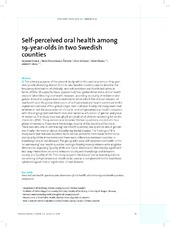Self-perceived oral health among 19-year-olds in two Swedish counties
Peer reviewed, Journal article
Published version

View/
Date
2008Metadata
Show full item recordCollections
Abstract
The primary purpose of the present study, which focused on a census of 19-yearolds (2006) attending dental clinics in two Swedish counties, was to describe the frequency distribution of clinically- and self-perceived oral health indicators in terms of DSa (Decayed Surfaces approximal), four global dimensions of oral health and one ‘all-embracing’ oral health measure, according to county of residence and gender. A second purpose was to examine to what extent the clinical indicator of oral health and the global dimensions of self-perceived oral health contribute to the explainable variance of the global single-item indicator. Finally, the study examined whether or not the association of clinically- and self-perceived oral health indicators with the single global oral health indicator varied as a function of gender and place of residence. The study base was 46.5% (n=3658) of all children attending for dental checks (n=7866). The questionnaire included thirteen questions, divided into four global dimensions. These were Knowledge, Quality of life, Social and Function. There was also one ‘all-embracing’ oral health question, one question about gender and finally information about clinically-registered disease. The findings of this study were that females reported more serious problems than males in the Social and Quality of life dimensions and there were differences between counties in knowledge about oral diseases. The group with poor self-reported oral health in the ‘all-embracing’ oral health question had significantly more problems with all global dimensions, especially Quality of life and Social dimensions. Statistically-significant two-way interactions occurred between county and Knowledge and between county and Quality of life. This study supports the idea of one or several questions concerning self-perceived oral health to be used as a complement to the traditional epidemiological clinical registration of oral diseases.